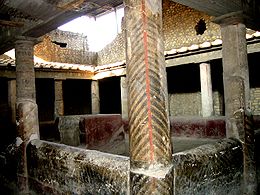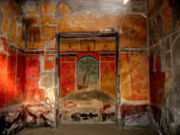
Villa Poppaea
Encyclopedia

Naples
Naples is a city in Southern Italy, situated on the country's west coast by the Gulf of Naples. Lying between two notable volcanic regions, Mount Vesuvius and the Phlegraean Fields, it is the capital of the region of Campania and of the province of Naples...
and Sorrento
Sorrento
Sorrento is the name of many cities and towns:*Sorrento, Italy*Sorrento, Florida, United States*Sorrento, Louisiana, United States*Sorrento, Maine, United States*Sorrento, Victoria, a township on the Mornington Peninsula, Victoria, Australia...
, in southern Italy
Italy
Italy , officially the Italian Republic languages]] under the European Charter for Regional or Minority Languages. In each of these, Italy's official name is as follows:;;;;;;;;), is a unitary parliamentary republic in South-Central Europe. To the north it borders France, Switzerland, Austria and...
, which dates from the early Imperial times.
The villa is a large structure situated in the Roman town of Oplontis
Oplontis
Oplontis was a town near Pompeii, in the Roman Empire. On August 24, AD 79, the eruption of Mount Vesuvius buried it under a deep layer of ash. It is today the location of the Villa Poppaea, the villa of the wife of Emperor Nero, which was excavated in the mid-20th century and is open to the...
(the modern Torre Annunziata
Torre Annunziata
Torre Annunziata is a city and comune in the province of Naples, region of Campania in Italy. It is located at the Gulf of Naples at the foot of Mt. Vesuvius.-History:...
), about ten metres below the modern level. It was owned by the Emperor Nero
Nero
Nero , was Roman Emperor from 54 to 68, and the last in the Julio-Claudian dynasty. Nero was adopted by his great-uncle Claudius to become his heir and successor, and succeeded to the throne in 54 following Claudius' death....
, and used by his second wife Poppaea Sabina
Poppaea Sabina
Poppaea Sabina and sometimes referred to as Poppaea Sabina the Younger to differentiate her from her mother of the same name, was a Roman Empress as the second wife of the Emperor Nero. Prior to this she was the wife of the future Emperor Otho...
as her main residence when not in Rome. The archeological evidence suggests that at the time of the eruption of Vesuvius in 79, the villa was empty, in the process of being rebuilt and redecorated, possibly in the aftermath of the earthquake of 62
62 Pompeii earthquake
The 62 Pompeii earthquake occurred on 5 February. It had an estimated magnitude of between 5 and 6 and a maximum intensity of XI or X on the Mercalli intensity scale. The towns of Pompeii and Herculaneum were severely damaged. The earthquake may have been a precursor to the eruption of Mount...
. Nero had killed Poppaea in 65, according to Suetonius by kicking her in the abdomen when she was in late pregnancy.

Discovery
Though the site of the villa was rediscovered during brief excavations carried out by Francesco La Vega in the eighteenth century, the swimming pool, which measures 60 by 15 meters, was not unearthed until the 1970s. The villa's gardens have been discussed by Wilhelmina F. Jashemski, The Gardens of Pompeii, Herculaneum, and the Villas Destroyed by Vesuvius (New Rochelle 1979) and the forty-five sculptures found at the villa were discussed by Stefano De Caro in Ancient Roman Villa Gardens, Elizabeth Blair MacDougall, editor (Dumbarton Oaks Colloquium 10, 1987).Nearby villa
Nearby is the more recently uncovered Villa of L. Crassius Tertius, discovered in 1974. A bronze seal found at the site gave the name of its last owner. This villa, which contained a large number of amphoraAmphora
An amphora is a type of vase-shaped, usually ceramic container with two handles and a long neck narrower than the body...
e, was not deserted at the time of the eruption: beside the bodies of the unfortunate victims, coins and jewelry were also found.

